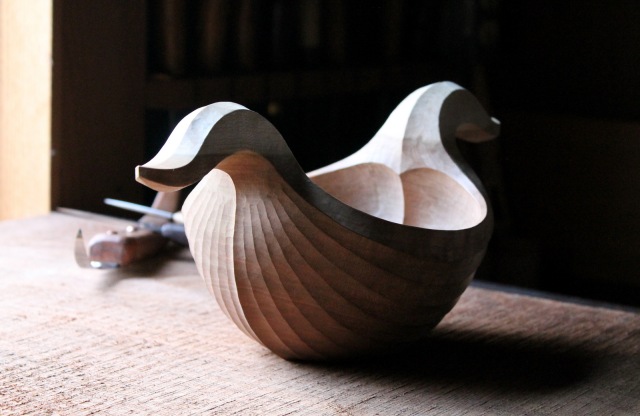
If you’ve seen my noggin, you know this post won’t be about hair care. Over the weekend, I finished the dry-stage carving of an ale bowl I had roughed out a couple months ago. I thought it might be a good opportunity to briefly discuss my oiling procedure.
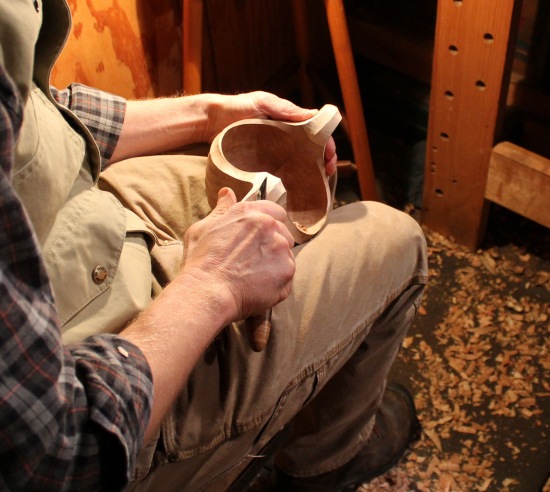
The most important factor in finishing is the quality of the final cuts. A properly sharpened edge will leave a cleanly cut, almost burnished, surface behind.
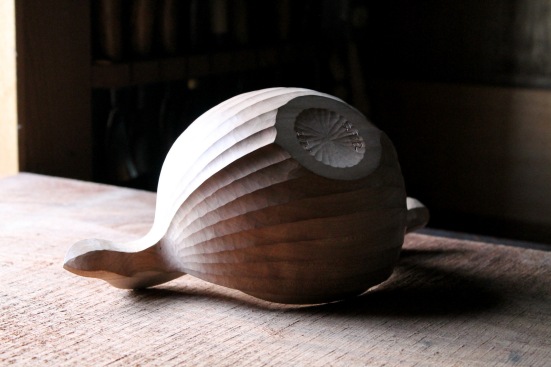
Once the carving is done, I pour some flax seed (linseed) oil into the bowl, then dip my fingers right in and slather oil all over the bowl.
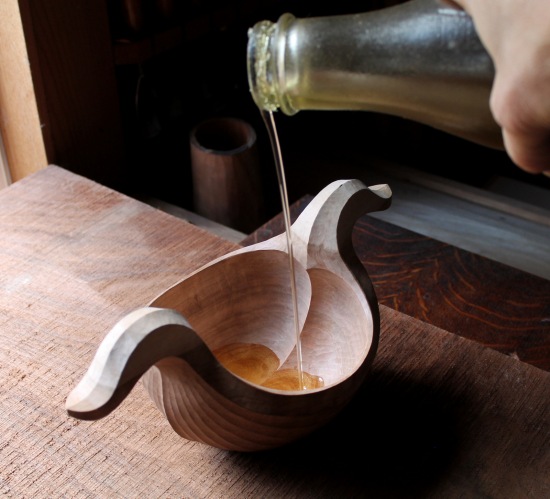
I’ve explored many rabbit holes regarding oil choice and all of that, and I know it is a subject with a depth and breadth beyond this post. One thing these natural oils have in common is a long curing time — potentially months. Time to turn up the heat.
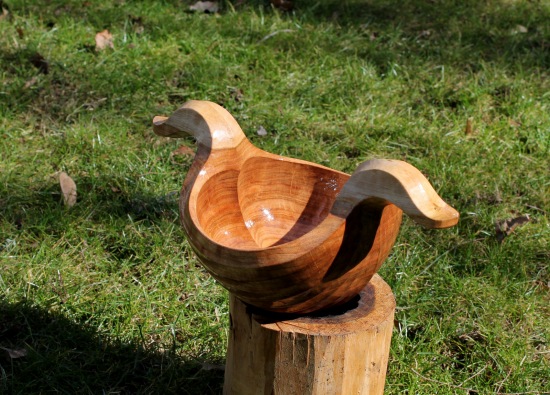
I have found that heat drastically reduces the drying time of these oils. In the heat of summer, I place a newly oiled bowl in direct sunlight. We were treated to a beautifully sunny weekend but the sunlight is not intense enough now.
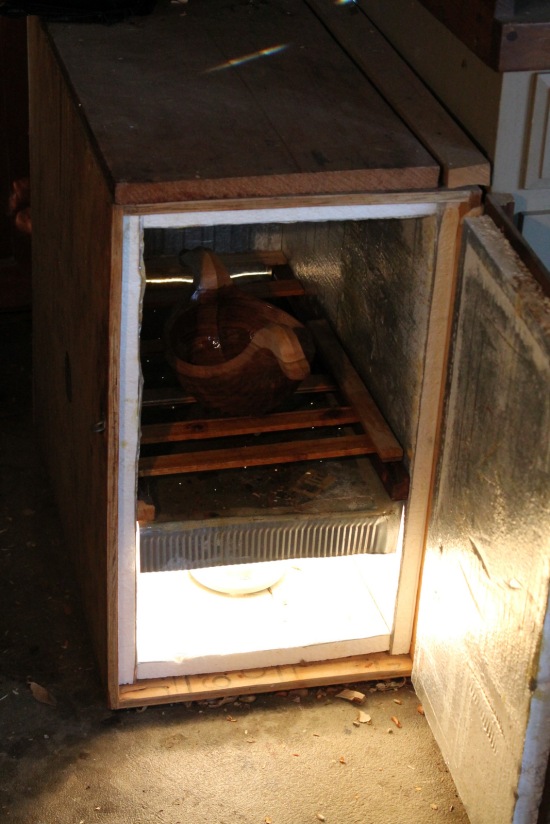
At other times of year, I’ll place a bowl in front of the fireplace or in a little light bulb kiln that I made for drying chair rungs years ago and I still use it for that occasionally. Based on a design by Jennie Alexander, It is simply a plywood box lined with foil-faced insulation board. There’s a sheet metal baffle above two porcelain fixtures. It is essentially an Easy-bake oven and the temperature can be controlled by varying the wattage of the bulbs. My wife even uses it for making yogurt. With two forty watt bulbs, it maintains a temperature of about 120-130 degrees Fahrenheit.
After a couple hours, I rub off or rub in any excess surface oil. Then, after a day or so in the box, I’ll begin with other coats, moving on to a blend of flax oil and beeswax.


Is it a kestrel knife I can see on the first and last picture? Beautiful ale bowl btw.
LikeLike
Thanks. Yes, that is Kestrel’s e-bend with my handle. Their stock handles are nicer. I like that knife for the inside of the deep hollows of these ale bowls.
LikeLike
Homemade yogurt??? Boy, did you ever marry well!
LikeLike
No kidding! Everyone tells me that — especially those that know us well! But she never wants for wood chips.
LikeLike
I like that picture of your drier. My incubator box has been working quite well for oiling my bowls in the winter also. It is a plywood box about 12″ by 30″ and 12″ deep. I use a 60 watt bulb which keeps it around 100 to 110 degrees. It’s not really a drier, one hole on each end for a little convection action. A window on the top lid to see what is going on inside. No chickens have been hatching in there yet.
LikeLike
Maybe I should have mentioned there is 3/4″ styrofoam insulation inside the box. Just in case anyone else is thinking. And… Dave in my dreams…… your work is out of this world!!!
LikeLiked by 1 person
Thanks for sharing your experience, Paul. An incubator box is a good idea.
LikeLike
So David, do you buy your Flax seed oil at the health food store or raw linseed oil at the local paint store, are they exactly the same? John
LikeLike
Well, they are not exactly the same, John. The subject is deeper than this, but I’ll summarize. It is all oil from flax seeds, but to be labeled flax seed, it is a food-grade product — so usually sold in health food stores or well-stocked grocery stores. Flax seed oil is cold pressed by purely mechanical means. It is usually light in color. I suppose it would also have to be processed in a food-safe facility and all that.
“Raw Linseed oil” (sometimes sold at hardware stores), like flax seed oil, is free of chemical drying agents but may be processed differently than flax seed oil. In addition to cold pressing, they can extract additional oil from the pressed mash by adding chemical solvents like hexane and then completely removing the solvent afterwards through evaporation or distillation. So “Raw linseed oil” should still be free of any toxins.
The stuff labeled “boiled linseed oil” at the hardware store is not truly boiled — a process that goes back a long way. Rather, chemical drying agents — heavy metals — have been added to speed curing time. So there are toxins in the final product that you expose yourself to when applying it.
Yet another distinction, even among flax and/or raw oils is whether it has undergone polymerization or pre-oxidation. The stuff from health food stores has undergone neither. I have purchased larger quantities from https://www.soapgoods.com/Flaxseed-Oil-p-580.html . A couple varieties are here http://solventfreepaint.com/cleaned_linseed_oil.htm including truly boiled. Tried and True products http://www.triedandtruewoodfinish.com/ are all based on polymerized oil. There are differences, but they will all work in the end.
LikeLiked by 1 person
David, thank you much for that info., I do a lot of spoons and am always on the lookout for a finish that will offer a little more sheen. I’ve been happy using Wheelers Wood Oil which is a walnut/tongue oil mix, but it seems it is no longer being produce. I think I will give Tried and True products a try or maybe Mahoneys. Again thanks for the info. John
LikeLike
Thank you for the question: that was one of mine too!
LikeLike
Your bowl work is just astounding to me! I hope to someday see and touch one of your bowls in person, the carved finish you acquire is hard for me to fathom. Love your blog, please keep up the great work! Thank’s for all the info you share. John
LikeLiked by 2 people
I’m new to bowl carving am am starting to learn the craft by carving cherry spoons for Christmas gifts. I saw the proportions for beeswax and flax seed oil but now can’t seem to locate it, Can you provide those again, Thanks for your generous sharing of knowledge. It is inspirational. Jack
LikeLike
There’s no magic proportion, but I find a ratio of about 8 fluid ounces of flax oil to about 1 ounce (by weight) of beeswax makes a nice consistency. I have more details here https://davidffisher.com/usecare
LikeLike
Pingback: On Eating Spoons and Such | David Fisher, Carving Explorations